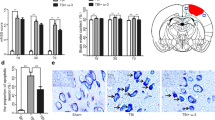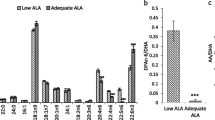Abstract
The transformation of microglia to a pro-inflammatory phenotype at the site of traumatic brain injury (TBI) drives the progression of secondary neurodegeneration and irreversible neurological impairment. Omega-3 polyunsaturated fatty acids (PUFA) have been shown to suppress this phenotype transformation, thereby reducing neuroinflammation following TBI, but the molecular mechanisms are unknown. We found that Omega-3 PUFA suppressed the expression of disintegrin metalloproteinase (ADAM17), the enzyme required to convert tumor necrosis factor-α (TNF-α) to the soluble form, thereby inhibiting the TNF-α/NF-κB pathway both in vitro and in a mouse model of TBI. Omega-3 PUFA also prevented the reactive transformation of microglia and promoted the secretion of microglial exosomes containing nerve growth factor (NGF), activating the neuroprotective NGF/TrkA pathway both in culture and TBI model mice. Moreover, Omega-3 PUFA suppressed the pro-apoptotic NGF/P75NTR pathway at the TBI site and reduced apoptotic neuronal death, brain edema, and disruption of the blood–brain barrier. Finally, Omega-3 PUFA preserved sensory and motor function as assessed by two broad-spectrum test batteries. The beneficial effects of Omega-3 PUFA were blocked by an ADAM17 promotor and by a NGF inhibitor, confirming the pathogenic function of ADAM17 and the central neuroprotective role of NGF. Collectively, these findings provide a strong experimental basis for Omega-3 PUFA as a potential clinical treatment for TBI.







Similar content being viewed by others
Data Availability
The datasets generated and/or analyzed for the present study are available from the corresponding author on reasonable request.
Abbreviations
- TBI:
-
Traumatic brain injury
- TNF-α:
-
Tumor necrosis factor-α
- ADAM17:
-
Extracellular a disintegrin metalloproteinase 17
- LPS:
-
Lipopolysaccharide
- IL:
-
Interleukin
- NF-κB:
-
Nuclear factor-κB
- NGF:
-
Nerve growth factor
- CCI:
-
Controlled cortical impact
- DHA:
-
Docosahexaenoic acid
- PMA:
-
Phorbol 12-myristate 13-acetate
- TNFR1:
-
Type 1 TNF receptor
- p-IκB:
-
Phosphorylated NF-κB inhibitory protein
- TEM:
-
Transmission electron microscopy
- P75NTR:
-
p75 neurotrophic factor receptor
- p-TrkA:
-
Phosphorylated tyrosine protein kinase A
- EB:
-
Evans blue
- Icam-1:
-
Intercellular adhesion molecule-1
- Hspa8:
-
Heat shock protein 8
- GUF-1:
-
GTPase homolog1
- FGG:
-
Fibrinogen gamma
- BBB:
-
Blood–brain barrier
References
Jiang JY, Gao GY, Feng JF et al (2019) Traumatic brain injury in China. Lancet Neurol 18(3):286–295
Schwenkreis P, Gonschorek A, Berg F et al (2021) Prospective observational cohort study on epidemiology, treatment and outcome of patients with traumatic brain injury (TBI) in German BG hospitals. BMJ Open 11(6):e045771
Capizzi A, Woo J, Verduzco-Gutierrez M (2020) Traumatic brain injury: an overview of epidemiology, pathophysiology, and medical management. Med Clin North Am 104(2):213–238
Milleville KA, Awan N, Disanto D et al (2021) Early chronic systemic inflammation and associations with cognitive performance after moderate to severe TBI. Brain Behav Immun Health 11:100185
Liu LR, Liu JC, Bao JS et al (2020) Interaction of microglia and astrocytes in the neurovascular Unit. Front Immunol 11:1024
Henry RJ, Ritzel RM, Barrett JP et al (2020) Microglial depletion with CSF1R inhibitor during chronic phase of experimental traumatic brain injury reduces neurodegeneration and neurological deficits. J Neurosci 40(14):2960–2974
Yang G, Cui M, Jiang W et al (2021) Molecular switch in human diseases-disintegrin and metalloproteinases, ADAM17. Aging (Albany NY) 13(12):16859–16872
Hirayama A, Awano S, Seta Y et al (2017) ADAM17 regulates TNF-α expression upon lipopolysaccharide stimulation in oral keratinocytes. Biomed Res 38(3):157–165
Xu X, Piao HN, Aosai F et al (2020) Arctigenin protects against depression by inhibiting microglial activation and neuroinflammation via HMGB1/TLR4/NF-κB and TNF-α/TNFR1/NF-κB pathways. Br J Pharmacol 177(22):5224–5245
Zhou X, Huang Z, Zhang J et al (2021) Chronic oral administration of magnesium-L-threonate prevents oxaliplatin-induced memory and emotional deficits by mormalization of TNF-α/NF-κB signaling in rats. Neurosci Bull 37(1):55–69
Brymer KJ, Romay-Tallon R, Allen J et al (2019) Exploring the potential antidepressant mechanisms of TNFα antagonists. Front Neurosci 13:98
Tuttolomondo A, Pecoraro R, Pinto A (2014) Studies of selective TNF inhibitors in the treatment of brain injury from stroke and trauma: a review of the evidence to date. Drug Des Devel Ther 8:2221–2238
Pooladanda V, Thatikonda S, Bale S et al (2019) Nimbolide protects against endotoxin-induced acute respiratory distress syndrome by inhibiting TNF-α mediated NF-κB and HDAC-3 nuclear translocation. Cell Death Dis 10(2):81
Gerhauser I, Hansmann F, Puff C et al (2012) Theiler’s murine encephalomyelitis virus induced phenotype switch of microglia in vitro. J Neuroimmunol 252(1-2):49–55
Li SR, Man QW, Gao X et al (2021) Tissue-derived extracellular vesicles in cancers and non-cancer diseases: present and future. J Extracell Vesicles 10(14):e12175
Luong N, Olson JK (2021) Exosomes secreted by microglia during virus infection in the central nervous system activate an inflammatory response in bystander cells. Front Cell Dev Biol 9:661935
Huang S, Ge X, Yu J et al (2018) Increased miR-124-3p in microglial exosomes following traumatic brain injury inhibits neuronal inflammation and contributes to neurite outgrowth via their transfer into neurons. FASEB J 32(1):512–528
Chen X, Qian B, Kong X et al (2019) A20 protects neuronal apoptosis stimulated by lipopolysaccharide-induced microglial exosomes. Neurosci Lett 712:134480
Wei M, Li C, Yan Z et al (2021) Activated microglia exosomes mediated miR-383-3p promotes neuronal necroptosis through inhibiting ATF4 expression in intracerebral hemorrhage. Neurochem Res 46(6):1337–1349
Pascual M, Ibáñez F, Guerri C (2020) Exosomes as mediators of neuron-glia communication in neuroinflammation. Neural Regen Res 15(5):796–801
Song Y, Li Z, He T et al (2019) M2 microglia-derived exosomes protect the mouse brain from ischemia-reperfusion injury via exosomal miR-124. Theranostics 9(10):2910–2923
Devanney NA, Stewart AN, Gensel JC (2020) Microglia and macrophage metabolism in CNS injury and disease: the role of immunometabolism in neurodegeneration and neurotrauma. Exp Neurol 329:113310
Zhang E, Wan X, Yang L et al (2020) Omega-3 polyunsaturated fatty acids alleviate traumatic brain injury by regulating the glymphatic pathway in mice. Front Neurol 11:707
Ren H, Yang Z, Luo C et al (2017) Enriched endogenous Omega-3 fatty acids in mice ameliorate parenchymal cell death after traumatic brain injury. Mol Neurobiol 54(5):3317–3326
Lin C, Chao H, Li Z et al (2017) Omega-3 fatty acids regulate NLRP3 inflammasome activation and prevent behavior deficits after traumatic brain injury. Exp Neurol 290:115–122
Talamonti E, Sasso V, To H et al (2020) Impairment of DHA synthesis alters the expression of neuronal plasticity markers and the brain inflammatory status in mice. Faseb j 34(2):2024–2040
Carey AN, Fisher DR, Bielinski DF et al (2020) Walnut-associated fatty acids inhibit LPS-induced activation of BV-2 microglia. Inflammation 43(1):241–250
Chen X, Wu S, Chen C et al (2017) Omega-3 polyunsaturated fatty acid supplementation attenuates microglial-induced inflammation by inhibiting the HMGB1/TLR4/NF-κB pathway following experimental traumatic brain injury. J Neuroinflammation 14(1):143
Sebastiani A, Gölz C, Werner C et al (2015) Proneurotrophin binding to P75 neurotrophin receptor (P75ntr) is essential for brain lesion formation and functional impairment after experimental traumatic brain injury. J Neurotrauma 32(20):1599–1607
Zhou D, Ji L, Chen Y (2020) TSPO Modulates IL-4-induced microglia/macrophage M2 polarization via PPAR-γ pathway. J Mol Neurosci 70(4):542–549
Bhowmick S, D'mello V, Caruso D et al (2019) Impairment of pericyte-endothelium crosstalk leads to blood-brain barrier dysfunction following traumatic brain injury. Exp Neurol 317:260–270
Nguyen R, Fiest KM, Mcchesney J et al (2016) The international incidence of traumatic brain injury: a systematic review and meta-analysis. Can J Neurol Sci 43(6):774–785
Witcher KG, Bray CE, Chunchai T et al (2021) Traumatic brain injury causes chronic cortical inflammation and neuronal dysfunction mediated by microglia. J Neurosci 41(7):1597–1616
Wojdasiewicz P, Poniatowski ŁA, Turczyn P et al (2020) Significance of Omega-3 fatty acids in the prophylaxis and treatment after spinal cord Iinjury in rodent models. Mediators Inflamm 2020:3164260
Holtman IR, Skola D, Glass CK (2017) Transcriptional control of microglia phenotypes in health and disease. J Clin Invest 127(9):3220–3229
Horiuchi T, Mitoma H, Harashima S et al (2010) Transmembrane TNF-alpha: structure, function and interaction with anti-TNF agents. Rheumatology (Oxford) 49(7):1215–1228
Black RA, Rauch CT, Kozlosky CJ et al (1997) A metalloproteinase disintegrin that releases tumour-necrosis factor-alpha from cells. Nature 385(6618):729–733
Desai A, Chen H, Kevala K et al (2021) Higher n-3 polyunsaturated fatty acid diet improves long-term neuropathological and functional outcome after repeated mild traumatic brain injury. J Neurotrauma 38(18):2622–2632
Zendedel A, Habib P, Dang J et al (2015) Omega-3 polyunsaturated fatty acids ameliorate neuroinflammation and mitigate ischemic stroke damage through interactions with astrocytes and microglia. J Neuroimmunol 278:200–211
Janas T, Janas MM, Sapoń K et al (2015) Mechanisms of RNA loading into exosomes. FEBS Lett 589(13):1391–1398
Zhao C, Deng Y, He Y et al (2021) Decreased level of exosomal miR-5121 released from microglia suppresses neurite outgrowth and synapse recovery of neurons following traumatic brain injury. Neurotherapeutics 18(2):1273–1294
Li D, Huang S, Yin Z et al (2019) Increases in miR-124-3p in microglial exosomes confer neuroprotective effects by targeting FIP200-mediated neuronal autophagy following traumatic brain injury. Neurochem Res 44(8):1903–1923
Stansley B, Post J, Hensley K. A comparative review of cell culture systems for the study of microglial biology in Alzheimer’s disease. J Neuroinflammation, 2012, 9: 115.
Marlin MC, Li G (2015) Biogenesis and function of the NGF/TrkA signaling endosome. Int Rev Cell Mol Biol 314:239–257
Acknowledgements
Sincere appreciation is also given to the teachers and our colleagues from the 900th Hospital, who participated in this study with great cooperation.
Funding
Joint Funds for the Innovation of Science and Technology, Fujian Province (Grant number: 2019Y9045); the 900th Hospital of Commanding Project and Special Treatment for Trauma (Grant number: 2022ZL03); Quanzhou City Science and Technology Program of China (Grant number:2022C030R); Joint Funds for the innovation of science and Technology, Fujian province (Grant number: 2020Y9033).
Author information
Authors and Affiliations
Contributions
LL: conceptualization (equal); formal analysis (equal); methodology (equal); writing—original draft (equal). SZ: formal analysis (equal); methodology (equal); software (equal). JL: data curation (equal); methodology (equal). DY: project administration (equal); formal analysis (equal). QH: project administration (equal); formal analysis (equal). ZW: methodology (equal); formal analysis (equal). XC: formal analysis (equal); methodology (equal); writing—review and editing (equal); funding acquisition (equal). SW: conceptualization (equal); funding acquisition (equal); project administration (equal); supervision (equal); writing—review and editing (equal).
Corresponding authors
Ethics declarations
Ethics Approval
All protocols in this study were approved by the Committee on the Ethics of Animal Experiments of 900th Hospital of PLA (approval number: 2020-068), in compliance with the Guide for the Care and Use of Laboratory Animals published by the NIH.
Consent to Participate
Not applicable.
Consent for Publication
Not applicable.
Conflict of Interest
The authors declare no competing interests.
Additional information
Publisher’s Note
Springer Nature remains neutral with regard to jurisdictional claims in published maps and institutional affiliations.
Rights and permissions
Springer Nature or its licensor (e.g. a society or other partner) holds exclusive rights to this article under a publishing agreement with the author(s) or other rightsholder(s); author self-archiving of the accepted manuscript version of this article is solely governed by the terms of such publishing agreement and applicable law.
About this article
Cite this article
Lin, L., Zheng, S., Lai, J. et al. Omega-3 Polyunsaturated Fatty Acids Protect Neurological Function After Traumatic Brain Injury by Suppressing Microglial Transformation to the Proinflammatory Phenotype and Activating Exosomal NGF/TrkA Signaling. Mol Neurobiol 60, 5592–5606 (2023). https://doi.org/10.1007/s12035-023-03419-3
Received:
Accepted:
Published:
Issue Date:
DOI: https://doi.org/10.1007/s12035-023-03419-3




